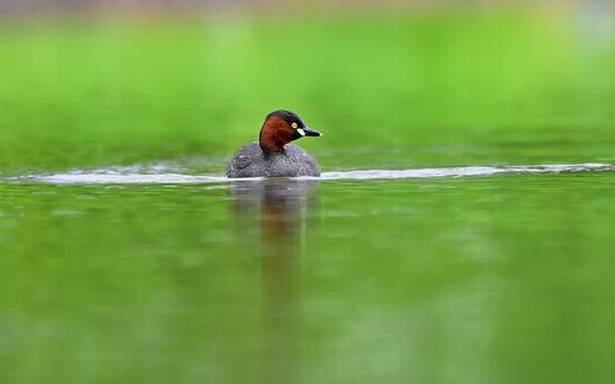Jayesh Padichal’s documentary explains why the rock pools and the ecosystem must be protected
A trickle of crystal clear water seeps through cracks in the laterite hill and tumbles into the sunshine, eventually flowing with hundreds of streams rushing through the hills till it merges with numerous tributaries to form rivers in North Kerala. The streams also feed natural ponds in the laterite, which are formed during the monsoon when rainwater gets collected in depressions. Called ‘pallom’ in Malayalam, these rocky ponds and wet landscapes support a unique ecosystem that is rich in flora and fauna.
Still of a jackal from Jayesh Padickal’s documentary, ‘Pallom Oru Jeevabhayam’, on rock pools and their unique ecosystem in Kasaragod | Photo Credit: Special arrangement
“As a wildlife enthusiast, photographer and filmmaker, I have been observing the change in seasons and life in and around the many such water bodies in the region. As the landscape is rapidly changing, I wanted to document the life supported by the water systems in these regions. That is why I made Pallom Oru Jeevabhayam (Pallom – An Ark of Life),” says Jayesh Padichal, who has directed and filmed the documentary.
Also Read | Get ‘First Day First Show’, our weekly newsletter from the world of cinema, in your inbox. You can subscribe for free here
Jayesh used to work as an autorickshaw driver till his deep interest in nature and photography turned him into a shutter bug and filmmaker. “Camps conducted by Payyannur-based Society for Environmental Education in Kerala helped me learn more about the environment and how each species is important for the health of the ecosystem,” says Jayesh.
A still from Jayesh Padickal’s documentary, ‘Pallom Oru Jeevabhayam’, on rock pools and their unique ecosystem in Kasaragod | Photo Credit: Special arrangement
Four years in the making, the 29-minute film focusses on the biodiversity that is nurtured by the pallom and its surroundings. As it flows, the streams nourish sacred groves (kavu) and woods (kananam), which are natural habitats for a wide variety of species such as birds, butterflies, frogs, fish, small reptiles, jackals and wild dogs, some of which are endemic to the region. This ancient region is said to have attracted nomads and their herds of cattle from the Deccan plateau due to the abundance of water.
Still from Jayesh Padickal’s documentary, ‘Pallom Oru Jeevabhayam’, on rock pools and their unique ecosystem in Kasaragod | Photo Credit: Special arrangement
Kammadam kavu, the biggest sacred groove in Kerala at over 60 acres, which is rich in biological diversity, lies in Kasaragod. The fragile ecosystem is dependent on the many shallow and deep ponds in the rocks and the streams that flow when the monsoon keeps its date with the Western Ghats.
Captivating frames of the life around the pallom has different species of birds breeding, nesting and feeding. Migratory birds like the rare White ibis make a splash while bull frogs and amphibians strike up a nocturnal jam session that goes on through the night.
“Some of these water bodies dry up in summer. In 2016, the rains failed and I saw hundreds of animals perish as the water levels went down. The migratory little grebe reaches these pools to nest and breed. The eggs are laid in nests built in the water and by September, the fledglings are ready to leave the nest. When the water vanished, I saw jackals feeding on the fledglings. Many animals perished that summer,” recalls Jayesh.
Jayesh Padickal, director of the documentary, ‘Pallom Oru Jeevabhayam’, on rock pools and their unique ecosystem in Kasaragod | Photo Credit: Special arrangement
In the midst of picturesque frames, Jayesh shows how the pristine environment is getting polluted when a little grebe builds a nest using water plants, mud and plastic bags floating on the water.
When the floods of 2018 devastated many districts of Kerala, Jayesh says that Kasaragod was not affected due to the natural contour of the land that prevented flooding and landslips. However, the documentary is a wake-up call as it shows the reddish laterite hills being demolished without taking into account the effects on the environment. Plastics of all kinds clog water bodies.
An ice-cream container is stuck on the neck of a young crow. A still from Jayesh Padickal’s documentary,‘Pallom Oru Jeevabhayam’, on rock pools and their unique ecosystem in Kasaragod | Photo Credit: Special arrangement
“Although I am extremely worried about the drastic changes in the landscape, I did not want my film to become a dry documentation of climate change. That I why I chose to document the varied life the pallom supports and how the food chain and life cycle of several species are disturbed when the landscape gets altered,” he explains.
Jayesh rues that not many are aware of the existence of palloms. “As the monsoon sets in, the ponds overflow and that is when the Puntius (a kind of freshwater fish) swims against the flow to breed in the ponds. It is known as Oothakayattam in Malayalam. I shot in all the seasons to show how the changes in nature affects living organisms. During the time of Onam, the hills are carpeted with blue bladderworts. Each season brings in significant changes in the surroundings,” he says.
With a poetic script and narration by environmental activist and author E Unnikrishnan, Pallom Oru Jeevabhayam has been screened for festivals and several leading groups of environmentalists. Produced under the banner of Ecofolks, the documentary is being released on June 5 (World Environment Day) on ROOTS OTT.
Source: Read Full Article


